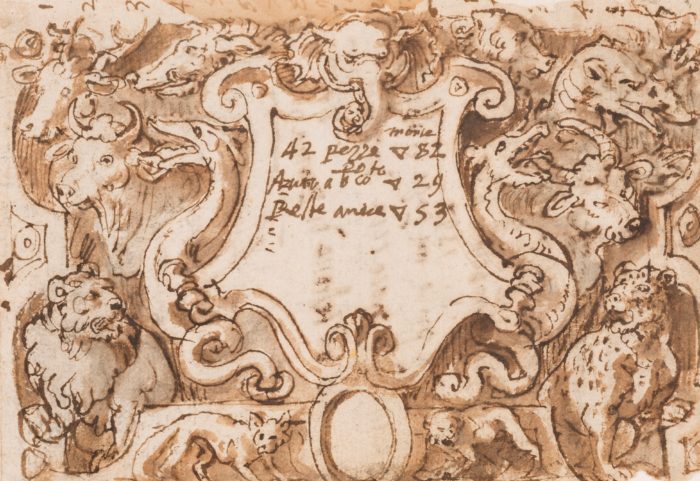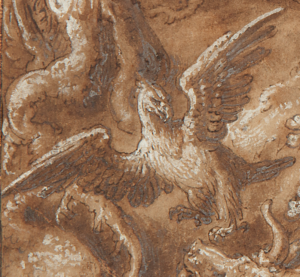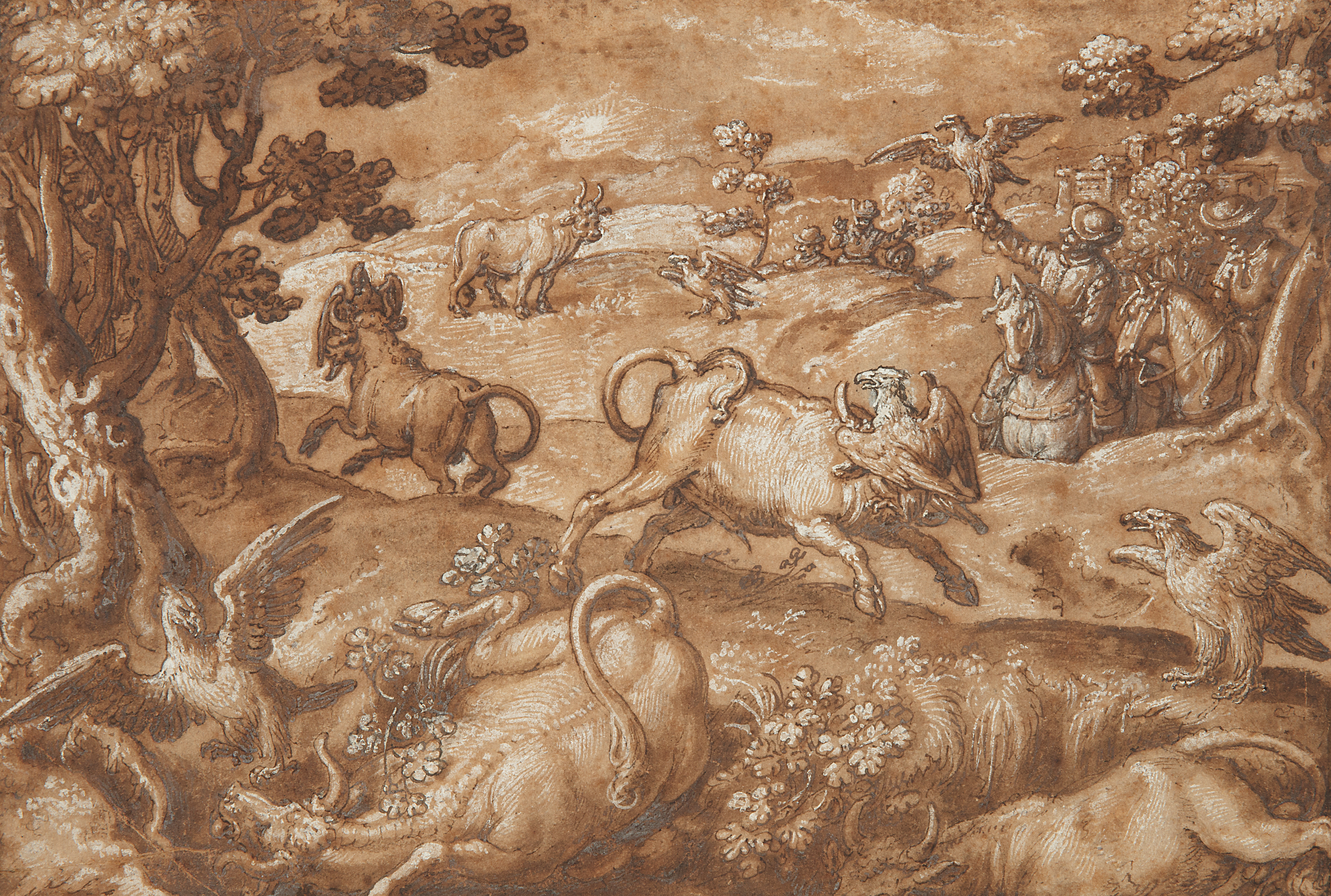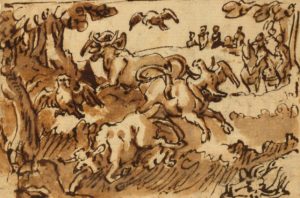Cooper Hewitt is delighted to add this extraordinary Renaissance drawing to the collection. A scene of “Men Hunting Bulls with Falcons,” it belongs to a series of (often outlandish) hunting images created by Jan van der Straet, called Stradanus (1523–1605). Cooper Hewitt is among the most important resources for the study of Stradanus, court artist to the Medici. The new acquisition unites this highly finished drawing with a preparatory sketch for the same composition, one of more than 300 sketches by Stradanus already in the museum’s collection.
Born in Bruges, Stradanus moved to Italy as a young man; he spent the rest of his life working in Florence, where he was known as “Giovanni Stradano.” Although initially successful in painting frescoes and designing tapestries for the Medici dukes, it was as an extremely prolific and sophisticated designer of prints that Stradanus earned global fame. He worked closely with engravers and publishers in Antwerp in order to produce hundreds of prints that were distributed all over the then-known world. We find evidence of their influence during his lifetime in locations as distant from Florence as Colonial Colombia and Momoyama Japan. Cooper Hewitt’s recently acquired Bull Hunt is the kind of large, highly finished drawing that Stradanus would produce towards the end of his creative process, the sort of design he would send to his publishers in order to have them translated into prints. They were never just tools, though: these impressive drawings have always been prized by collectors, even during Stradanus’s lifetime. The Bull Hunt is a stunning example of this type of large, carefully rendered drawing, the first of its kind by Stradanus to enter the collection—where it joins the museum’s numerous sketches by the artist.
Most of Cooper Hewitt’s Stradanus sketches, like many of its Renaissance drawings, were purchased for the collection by Sarah and Eleanor Hewitt, founders of the museum. The Hewitt sisters were dedicated to supporting working designers by providing exposure to the arts, believing an essential component of design education to be the study of the works of the past. And so, in building their museum, the sisters acquired large numbers of drawings and prints made in Western Europe in the sixteenth through the nineteenth centuries. A major coup was their purchase of nearly twelve thousand drawings from the collection of Giovanni Piancastelli (1845–1946), first director of the Borghese Gallery in Rome. Piancastelli was particularly interested in drawings that document the creative process, and those he sold to the Hewitt sisters typically constitute what might be described as working materials: there are, for example, designs for prints, architectural and stage designs, compositional sketches, figure studies, designs for decorative objects, and preparatory sheets related to wall or ceiling decorations.
In several fascinating instances, through the acquisition of the Piancastelli drawings, Cooper Hewitt became the primary repository for preparatory drawings by an individual artist, often boasting hundreds of examples by the same hand. These were kept together by the artists and their heirs, retained in the studio (rather than sold or discarded) for reference and inspiration. Such is the case with the museum’s Stradanus sketches. Quite famous among specialists, these are without exception small, rough, rapidly worked out drawings often referred to by scholars as the artist’s primi pensieri, or “first thoughts.” These drawings constitute a priceless record of his design practice, part a story that Cooper Hewitt, as the Nation’s design museum, is uniquely suited to tell. The exciting addition of the Bull Hunt unites for the very first time one of these “first thoughts”—a relatively insubstantial, quickly drawn composition in the collection (1901-39-167)—with Stradanus’s finished version of the same subject. The pairing not only illustrates the function of the preliminary sketches, but also more broadly illuminates the essential role played by drawing in the practice of design.
The subjects that appear in Stradanus’s drawings and prints are highly varied and celebrated for their intriguing combination of fantasy and scholarly invention. They represent, for example, mythological, religious, historical, and literary scenes. More famously, Stradanus also chronicled scientific and technological innovations, such as the invention of gunpowder, clockwork, copper engraving, the process of making silk, even the discovery of America. It was the hunt, however, that was by far his most frequent and popular subject.

Design for a Frontispiece with Animals, ca. 1597 (1901-39-2280); this design is intended for a printed frontispiece introducing a series of Stradanus’s hunting images
He probably first produced these designs as subjects for tapestries for Medici palaces and villas, but he went far beyond that scope, eventually composing more than 100 hunting images. These often feature surprising subjects, such as the capturing of ostriches, panthers, crocodiles, elephants, cuckoos, and unicorns. For inspiration, the artist turned to ancient sources, such as Pliny the Elder, as well as to recent reports from European explorers pushing the boundaries of Western knowledge. Both were exotic, and ripe fodder for his fertile imagination.
 In Cooper Hewitt’s Bull Hunt, trees frame the composition at left and right, opening out to a landscape of rolling terrain. The hunters appear on horseback in the background at right. Two bulls have fallen in the foreground, while others gallop through the center of the image. The birds—traditionally identified as falcons, although possibly eagles—alight on the heads of their prey, likely blinding them. The composition was probably created towards the end of Stradanus’s career, one in a series of hunting images published in several editions beginning in around 1596. Interestingly, the Bull Hunt (like some of the other hunting compositions Stradanus made at this time) was never engraved, a decision perhaps made by the publisher in Antwerp. More information regarding the creation, use, and legacy of Stradanus’s work will certainly emerge from continued examination of the museum’s unparalleled collection of his preparatory drawings. The recent acquisition of the Bull Hunt reflects Cooper Hewitt’s longstanding commitment—begun by the Hewitt sisters more than a century ago—to the study and promotion of Renaissance design.
In Cooper Hewitt’s Bull Hunt, trees frame the composition at left and right, opening out to a landscape of rolling terrain. The hunters appear on horseback in the background at right. Two bulls have fallen in the foreground, while others gallop through the center of the image. The birds—traditionally identified as falcons, although possibly eagles—alight on the heads of their prey, likely blinding them. The composition was probably created towards the end of Stradanus’s career, one in a series of hunting images published in several editions beginning in around 1596. Interestingly, the Bull Hunt (like some of the other hunting compositions Stradanus made at this time) was never engraved, a decision perhaps made by the publisher in Antwerp. More information regarding the creation, use, and legacy of Stradanus’s work will certainly emerge from continued examination of the museum’s unparalleled collection of his preparatory drawings. The recent acquisition of the Bull Hunt reflects Cooper Hewitt’s longstanding commitment—begun by the Hewitt sisters more than a century ago—to the study and promotion of Renaissance design.
Dr. Julia Siemon is Assistant Curator of Drawings, Prints & Graphic Design at Cooper Hewitt, Smithsonian Design Museum
Bull Hunt with Falcons was purchased from the Cooper Hewitt Members’ Acquisition Fund. A portion of membership dues for Design Watch members and above directly supports growing Cooper Hewitt’s permanent collection. Since the fund was established in 2013, members convene biannually to vote on a new acquisition, nominated by museum curators.

